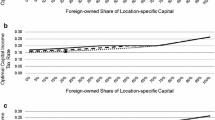Abstract
In a small open economy, the welfare effect of capital taxation depends on the allocation of the tax revenue as well as the tax system. If tax revenues are used to finance debt or government spending, an increase in either residential or territorial capital taxation will reduce the welfare of the representative individual. If tax revenues are transferred intergenerationally, an increase in the residential capital tax rate will increase the steady-state welfare when the after-tax interest rate is greater than the growth rate. If the revenue is rebated to the tax payer, an introduction of territorial capital taxation may increase welfare when the growth rate is relatively high. In the case where either the revenue from residential capital taxation is rebated to the tax payer or the revenue from territorial capital taxation is transferred intergenerationally, the welfare-maximizing tax rate appears to be zero.
Similar content being viewed by others
References
Batina, Raymond and Toshihiro Ihori (1991) “International Spillover Effects of Consumption Taxation,” Journal of the Japanese and International Economics 5, 404–420.
Bovenberg, A. Lans (1986) “Capital Income Taxation in Growing Open Economies,” Journal of Public Economics 31, 347–76.
Buiter, Willem H. (1981) “Time Preference and International Lending and Borrowing in an Overlapping Generations Model,” Journal of Political Economy 89, 769–97.
Chamely, Christopher (1981) “Welfare Cost of Capital Taxation in a Growing Economy,” Journal of Political Economy 89, 469–96.
——— “Optimal Taxation of Capital Income in General Equilibrium with Infinite Lives,” Econometrica 54, 607–22.
Diamond, Peter A. (1970) “Incidence of an Interest Income Tax,” Journal of Economic Theory 2, 211–24.
——— “National Debt in a Neoclassical Growth Model,” American Economic Review 55, 1125–50.
Dornbusch, Rudiger (1985) “Intergenerational and International Trade,” Journal of International Economics 19, 123–39.
Frenkel, Jacob A., Assaf Razin, and Efraim Sadka (1991) International Taxation in a IntegratedWorld. Cambridge, MA: MIT Press.
Giovannini, Alberto (1990) “Reforming Capital Income Taxation in the Open Economy: Theoretical Issues.” In Horst Siebert (ed.) Reforming Capital Income Taxation, Boulder: Westview.
Gordon, Roger (1986) “Taxation of Investment and Savings in a World Economy,” American Economic Review 76, 1086–102.
Ihori, Toshihiro (1991) “Capital Income Taxation in a World Economy: A Territorial System Versus a Residence System,” The Economic Journal 101, 958–65.
Judd, Kenneth L. (1985) “Redistributive Taxation in a Simple Perfect Foresight Model,” Journal of Public Economics 28, 59–83.
Keen, Michael (1990) “Welfare Effects of Capital Income Tax Reform in a GrowingWorld Economy,” Public Finance/Finances Publiques 45, 283–303.
Kotlikoff, Laurence J. and Lawrence H. Summers (1979) “Tax Incidence in a Life Cycle Model with Variable Labor Supply,” Quarterly Journal of Economics 93, 705–18.
Lucas, Robert E. (1990) “Supply-Side Economics: An Analytical Review,” Oxford Economic Papers 42, 293–316.
Nielsen, Soren Bo and Peter Birch Sorensen (1991) “Capital Income Taxation in a Growing Open Economy,” European Economic Review 23, 299–313.
Persson, Torsten (1985) “Deficits and Intergenerational Welfare in Open Economies,” Journal of International Economics 19, 67–84.
Phelps, Edmund (1961) “The Golden Rule of Accumulation,” American Economic Review 51, 638–43.
Samuelson, Paul A. (1958) “An Exact Consumption-Loan Model of Interest with or without the Social Contrivance of Money,” Journal of Political Economy 66, 467–82.
Sibert, Ann (1990) “Taxing Capital in a Large Open Economy,” Journal of Public Economics 41, 297–317.
Sinn, Hans-Werner (1987) Capital Income Taxation and Resource Allocation. Amsterdam: North-Holland.
Summers, Lawrence H. (1981) “Capital Taxation and Accumulation in a Life Cycle Growth Model,” American Economic Review 71, 533–44.
Author information
Authors and Affiliations
Rights and permissions
About this article
Cite this article
Lin, S., Zhang, W. Welfare Effects of Capital Taxation in a Small Open Economy. Open Economies Review 9, 5–20 (1998). https://doi.org/10.1023/A:1008240822015
Issue Date:
DOI: https://doi.org/10.1023/A:1008240822015




